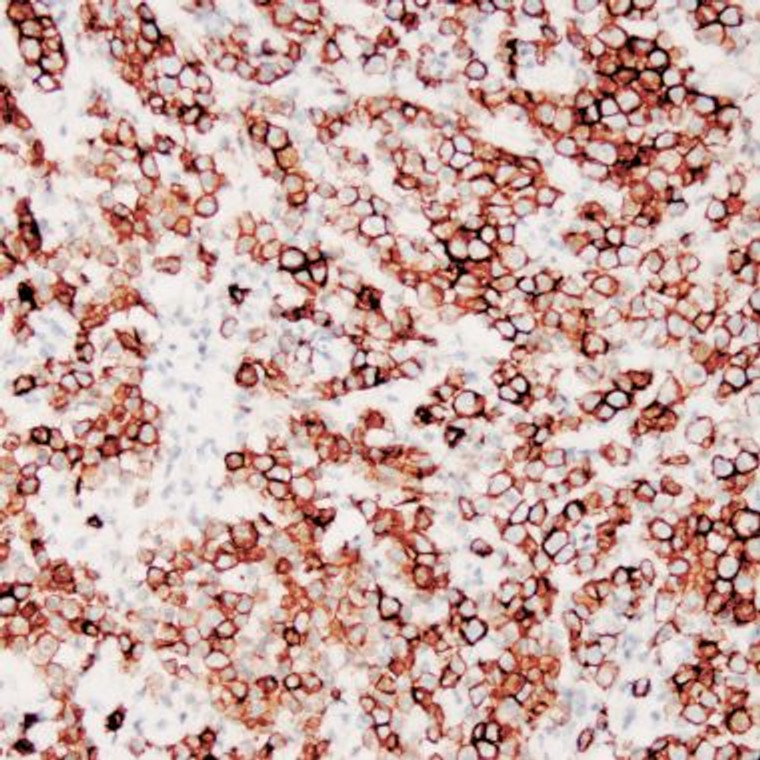| Host: |
Mouse |
| Applications: |
IHC-P |
| Reactivity: |
Human |
| Note: |
STRICTLY FOR FURTHER SCIENTIFIC RESEARCH USE ONLY (RUO). MUST NOT TO BE USED IN DIAGNOSTIC OR THERAPEUTIC APPLICATIONS. |
| Short Description: |
Mouse monoclonal antibody anti-PDPN is suitable for use in Immunohistochemistry research applications. |
| Clonality: |
Monoclonal |
| Clone ID: |
D2‐40 |
| Conjugation: |
Unconjugated |
| Isotype: |
IgG1/Kappa |
| Formulation: |
Tris-HCI buffer containing stabilizing protein (BSA) and <0.1% ProClin |
| Purification: |
Affinity purified |
| Dilution Range: |
1:20‐100 |
| Storage Instruction: |
Store at 2‐8°C for up to 24 months. Predilute: Ready to use, no reconstitution necessary. Concentrate: Use dilution range and appropriate lab‐standardized diluent. Stability after dilution: 7 days at 24°C, 3 months at 2‐8°C, 6months at ‐20°C. |
| Gene Symbol: |
PDPN |
| Gene ID: |
10630 |
| Uniprot ID: |
PDPN_HUMAN |
| Specificity: |
Positive control: Germ cell tumor |
| Immunogen: |
M2A |
| Tissue Specificity | Highly expressed in placenta, lung, skeletal muscle and brain. Weakly expressed in brain, kidney and liver. In placenta, expressed on the apical plasma membrane of endothelium. In lung, expressed in alveolar epithelium. Up-regulated in colorectal tumors and expressed in 25% of early oral squamous cell carcinomas. |
| Post Translational Modifications | Extensively O-glycosylated. Contains sialic acid residues. O-glycosylation is necessary for platelet aggregation activity. Disialylated at Thr-52.sialic acid is critical for platelet-aggregating activity and for CLEC1B interaction. The N-terminus is blocked. Cleaved by a metalloprotease within its extracellular (EC) domain, generating a membrane-bound C-terminal fragment (PCTF33) and an extracellular fragment. The resulting membrane-bound C-terminal fragment (PCTF33) is further processed between Val-150 and Val-151 by PSEN1/gamma-secretase generating the intracellular domain of podoplanin (PICD). |
| Function | Mediates effects on cell migration and adhesion through its different partners. During development plays a role in blood and lymphatic vessels separation by binding CLEC1B, triggering CLEC1B activation in platelets and leading to platelet activation and/or aggregation. Interaction with CD9, on the contrary, attenuates platelet aggregation induced by PDPN. Through MSN or EZR interaction promotes epithelial-mesenchymal transition (EMT) leading to ERZ phosphorylation and triggering RHOA activation leading to cell migration increase and invasiveness. Interaction with CD44 promotes directional cell migration in epithelial and tumor cells. In lymph nodes (LNs), controls fibroblastic reticular cells (FRCs) adhesion to the extracellular matrix (ECM) and contraction of the actomyosin by maintaining ERM proteins (EZR.MSN and RDX) and MYL9 activation through association with unknown transmembrane proteins. Engagement of CLEC1B by PDPN promotes FRCs relaxation by blocking lateral membrane interactions leading to reduction of ERM proteins (EZR.MSN and RDX) and MYL9 activation. Through binding with LGALS8 may participate in connection of the lymphatic endothelium to the surrounding extracellular matrix. In keratinocytes, induces changes in cell morphology showing an elongated shape, numerous membrane protrusions, major reorganization of the actin cytoskeleton, increased motility and decreased cell adhesion. Controls invadopodia stability and maturation leading to efficient degradation of the extracellular matrix (ECM) in tumor cells through modulation of RHOC activity in order to activate ROCK1/ROCK2 and LIMK1/LIMK2 and inactivation of CFL1. Required for normal lung cell proliferation and alveolus formation at birth. Does not function as a water channel or as a regulator of aquaporin-type water channels. Does not have any effect on folic acid or amino acid transport. |
| Protein Name | PodoplaninAggrusGlycoprotein 36Gp36Pa2.26 AntigenT1-AlphaT1a Cleaved Into - 29kda Cytosolic Podoplanin Intracellular DomainPicd |
| Database Links | Reactome: R-HSA-114604Reactome: R-HSA-9827857 |
| Cellular Localisation | Podoplanin: MembraneSingle-Pass Type I Membrane ProteinCell ProjectionLamellipodium MembraneFilopodium MembraneMicrovillus MembraneRuffle MembraneMembrane RaftApical Cell MembraneBasolateral Cell MembraneInvadopodiumLocalized To Actin-Rich Microvilli And Plasma Membrane Projections Such As FilopodiaLamellipodia And RufflesAssociation To The Lipid Rafts Is Required For Pdpn-Induced Epithelial To Mesenchymal Transition (Emt)Colocalizes With Cd9 In Tetraspanin MicrodomainsLocalized At Invadopodium Adhesion Rings In Tumor CellAssociation To The Lipid Rafts Is Essential For Pdpn Recruitment To Invadopodia And Ecm Degradation29kda Cytosolic Podoplanin Intracellular Domain: CytoplasmCytosol |
| Alternative Antibody Names | Anti-Podoplanin antibodyAnti-Aggrus antibodyAnti-Glycoprotein 36 antibodyAnti-Gp36 antibodyAnti-Pa2.26 Antigen antibodyAnti-T1-Alpha antibodyAnti-T1a Cleaved Into - 29kda Cytosolic Podoplanin Intracellular Domain antibodyAnti-Picd antibodyAnti-PDPN antibodyAnti-GP36 antibodyAnti-PSEC0003 antibodyAnti-PSEC0025 antibody |
Information sourced from Uniprot.org
12 months for antibodies. 6 months for ELISA Kits. Please see website T&Cs for further guidance






